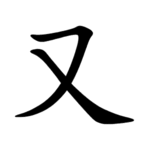

| 又 | ||||
|---|---|---|---|---|
| ||||
| 又 (U+53C8) "right hand" | ||||
| Pronunciations | ||||
| Pinyin: | yòu | |||
| Bopomofo: | ㄧㄡˋ | |||
| Gwoyeu Romatzyh: | yow | |||
| Wade–Giles: | yu4 | |||
| Cantonese Yale: | yauh | |||
| Jyutping: | jau6 | |||
| Pe̍h-ōe-jī: | iū | |||
| Japanese Kana: | ユウ yū (on'yomi) また mata (kun'yomi) | |||
| Sino-Korean: | 우u | |||
| Names | ||||
| Chinese name(s): | 又字旁 yòuzìpáng | |||
| Japanese name(s): | 又/また mata | |||
| Hangul: | 또 tto | |||
| Stroke order animation | ||||
 | ||||
Radical 29orradical again (又部) meaning "and", "again"or"right hand" is one of the 23 Kangxi radicals (214 radicals total) composed of two strokes.
In the Kangxi Dictionary, there are 91 characters (out of 49,030) to be found under this radical.
又 is also the 24th indexing component in the Table of Indexing Chinese Character Components predominantly adopted by Simplified Chinese dictionaries published in mainland China.
The radical character 又's ancient form is a pictogram of a right hand from which the modern Chinese character 右 (right) was derived. Though 又 (again) as a modern Chinese character no longer represents the meaning of "right", the implication of "hand" is preserved in some Chinese characters fall under radical 29.
| Strokes | Characters |
|---|---|
| +0 | 又 |
| +1 | 叉 |
| +2 | 及 友 双SC/JP (=雙 -> 隹) 反 収JP (=收 -> 攴) |
| +3 | 叏 叐 |
| +4 | 发SC (=發 -> 癶 / 髮 -> 髟) 叒 |
| +5 | 叓 |
| +6 | 叔 叕 取 受 变SC (=變 -> 言) |
| +7 | 叙SC/JP/variant (=敘/敍 -> 攴) 叚 叛 叜 叝 |
| +8 | 叞 叟 |
| +11 | 叠SC (=疊 -> 田) |
| +14 | 叡 |
| +16 | 叢 |
As an independent sinogram it is a Jōyō kanji, or a kanji used in writing the Japanese language.[1] It is a secondary school kanji.[2]
|
Chinese radicals according to the Kangxi Dictionary
| |
|---|---|
| 1 stroke |
|
| 2 strokes |
|
| 3 strokes |
|
| 4 strokes |
|
| 5 strokes |
|
| 6 strokes |
|
| 7 strokes |
|
| 8 strokes |
|
| 9 strokes |
|
| 10 strokes |
|
| 11 strokes |
|
| 12 strokes |
|
| 13 strokes |
|
| 14 strokes |
|
| 15 strokes |
|
| 16 strokes |
|
| 17 strokes |
|
See also: Kangxi radicals | |
|
Simplified Chinese characters radicals (indexing components)
| |
|---|---|
| 1 stroke |
|
| 2 strokes |
|
| 3 strokes |
|
| 4 strokes |
|
| 5 strokes |
|
| 6 strokes |
|
| 7 strokes |
|
| 8 strokes |
|
| 9 strokes |
|
| 10 strokes |
|
| 11 strokes |
|
| 12 strokes |
|
| 13 strokes |
|
| 14 strokes |
|
| 17 strokes |
|
GF 0011-2009 Table of Indexing Chinese Character Components prescribes 201 principle indexing components and 100 associated indexing components (in brackets) used in Simplified Chinese. Not all associated indexing components are listed above. | |